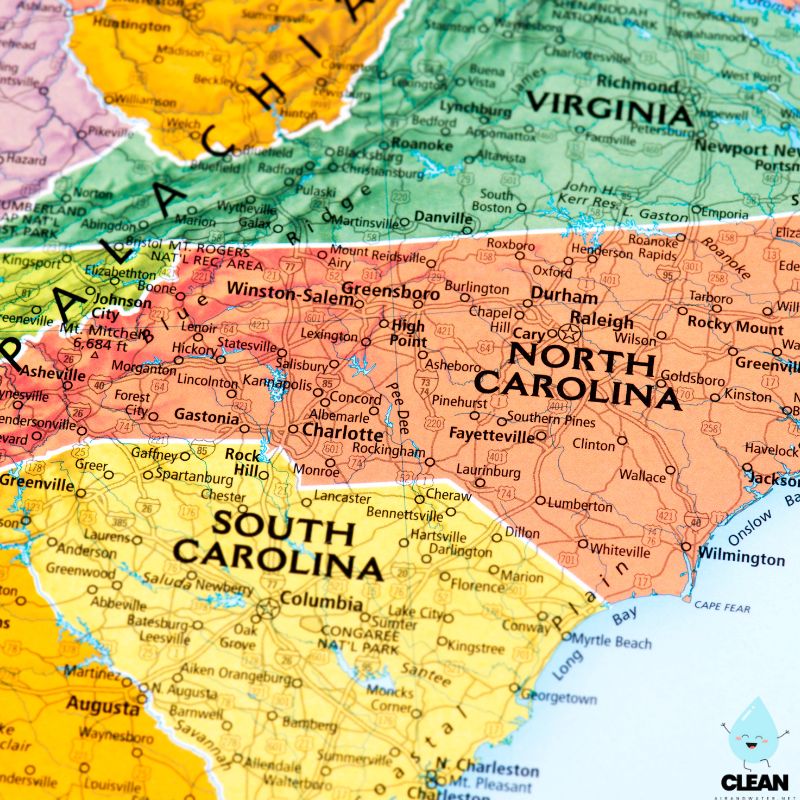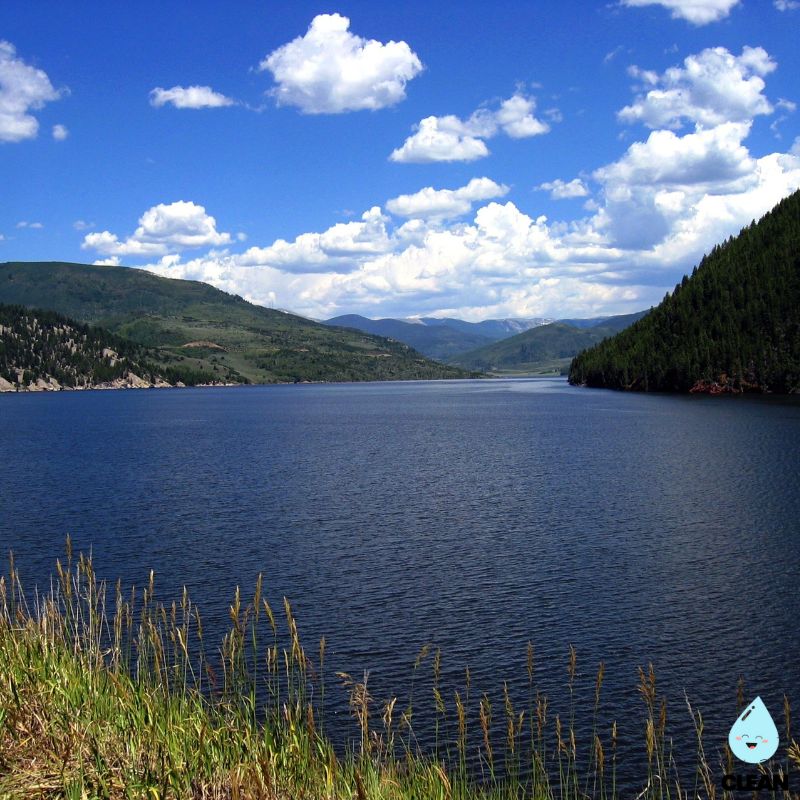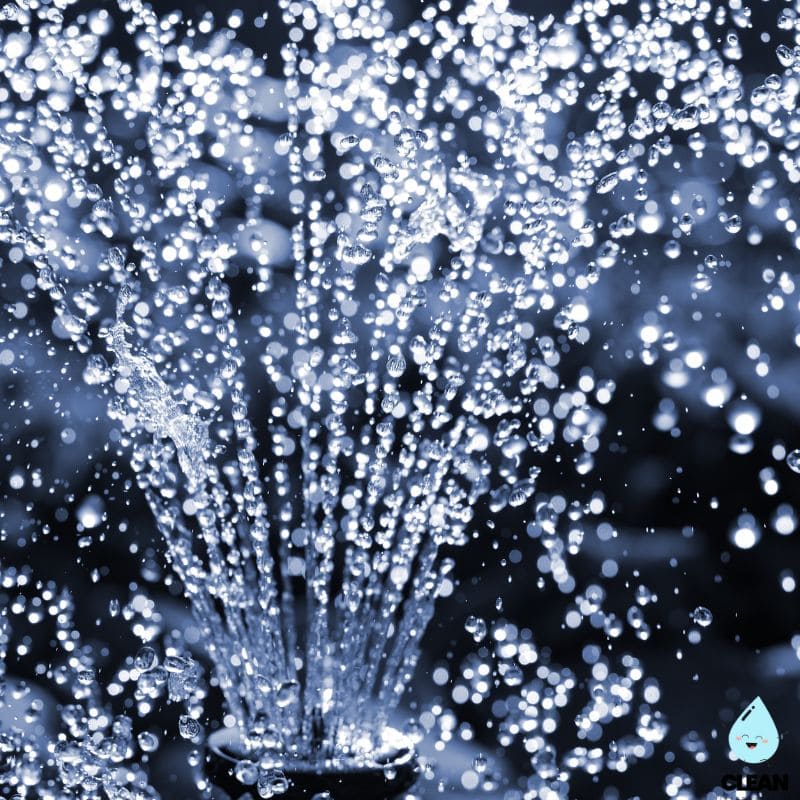North Carolina Water Quality at a Glance
widespread contamination
Is North Carolina Water Safe to Drink?
Technically Compliant, But Highly Concerning – North Carolina water meets federal standards but 47 community water systems exceed new EPA PFAS limits. Key issues include widespread PFAS contamination affecting 3.6 million residents, GenX chemicals from Chemours in the Cape Fear River Basin, and high levels of PFOS (30 ppt) and GenX (33 ppt) in some systems. North Carolina ranks as the third-highest state for PFAS exposure, with Cape Fear region serving as ground zero for contamination.
⚠️ Key Concerns for North Carolina Residents
- PFAS “Forever Chemicals”: 3.6 million residents have PFAS above federal limits; Robeson County found PFOS at 30 ppt and GenX at 33 ppt – both exceeding EPA standards
- Cape Fear River Crisis: Decades of GenX contamination from Chemours facility affecting 1.5 million residents; ongoing lawsuits and consent orders
- Industrial Contamination: Over 600 facilities may be discharging PFAS; wastewater plants don’t remove these chemicals from drinking water sources
- Private Well Concerns: 200,000 of 800,000 private well users (25%) exceed PFAS limits; limited regulatory oversight for well contamination
Read the full report below for detailed analysis, state-specific data, and actionable recommendations for North Carolina residents.
North Carolina – The Tar Heel State – Water Quality Report 2025: PFAS Testing, Infrastructure Concerns & Safety across your state
North Carolina’s water infrastructure serves approximately 10.7 million residents across diverse geographical regions, from the mountainous Blue Ridge in the west to the Outer Banks coastal plains in the east. The state operates through a complex network of over 2,800 public water systems, ranging from large municipal utilities like Charlotte Water, which serves over 1 million customers, to smaller rural systems providing essential services to underserved communities. North Carolina’s water sources include the Cape Fear, Neuse, Tar-Pamlico, and Catawba river systems, along with numerous reservoirs and groundwater aquifers that supply both urban centers and agricultural areas.
Despite abundant water resources, North Carolina faces significant infrastructure challenges. According to the American Society of Civil Engineers’ 2025 Infrastructure Report Card, North Carolina’s drinking water infrastructure requires an estimated $16.8 billion in investments over the next 20 years. The state has received over $265 million in federal infrastructure investments in 2025 from the Biden-Harris Administration’s Bipartisan Infrastructure Law to address these challenges, focusing on drinking water safety, wastewater treatment upgrades, and emerging contaminant removal including PFAS. North Carolina’s commitment to water quality improvement is demonstrated through partnerships between the North Carolina Department of Environmental Quality (NCDEQ), local utilities, and federal agencies working to ensure safe, reliable water access for all residents.

North Carolina Water Quality: Current Status (2024-2025)
Statewide Compliance and Testing
- Overall Compliance: The majority of North Carolina’s 2,800+ public water systems meet federal Safe Drinking Water Act standards, though over 300 systems have PFAS contamination levels above new EPA limits, including 42 municipal systems serving nearly 3 million residents combined.
- PFAS Monitoring: North Carolina has emerged as a national leader in PFAS testing and remediation, with comprehensive monitoring programs revealing some of the highest “forever chemical” concentrations in the country, particularly in the Cape Fear River Basin affecting over 1.5 million residents.
- Infrastructure Investment: Over $265 million in federal funding through the Bipartisan Infrastructure Law was allocated to North Carolina in 2025 for water infrastructure improvements, including $69.8 million specifically for PFAS treatment and disadvantaged communities.
Major Water Sources and Challenges
- Cape Fear River Basin: Primary drinking water source for over 1.5 million North Carolinians including Wilmington, facing severe PFAS contamination from decades of industrial discharge by DuPont/Chemours requiring ongoing treatment and monitoring.
- Neuse and Tar-Pamlico Rivers: Major sources for eastern North Carolina communities, experiencing challenges from agricultural runoff, emerging contaminants, and aging infrastructure requiring modernization and enhanced treatment.
- Statewide Infrastructure Needs: North Carolina requires an estimated $16.8 billion in drinking water infrastructure investments over the next 20 years, with particular challenges in rural and disadvantaged communities.
Emerging Contaminant Response
- PFAS Regulation Implementation: New EPA drinking water standards for PFOA and PFOS (4 parts per trillion) take effect in 2029, requiring significant infrastructure investments from affected water systems across the state, with about 2.5 million North Carolinians currently above these limits.
- Treatment Technology Deployment: Water utilities are implementing advanced treatment technologies including activated carbon filtration and reverse osmosis systems. The Cape Fear Public Utility Authority has invested $75 million in PFAS treatment, while Fayetteville’s system costs $92 million.
- Source Water Protection: NCDEQ has established comprehensive monitoring and minimization programs for industrial PFAS dischargers, though regulatory challenges have delayed implementation of stronger surface water standards.
Rural and Disadvantaged Communities
- Infrastructure Disparities: Rural water systems face disproportionate challenges with aging infrastructure, limited technical capacity, and higher per-capita costs for compliance with new regulations, with many systems requiring regionalization or consolidation.
- Targeted Federal Support: Dedicated funding streams through the Emerging Contaminant and Viable Utility Reserve programs provide grants and forgivable loans to ensure equitable access to safe drinking water in distressed communities.
- Technical Assistance Programs: NCDEQ and the State Water Infrastructure Authority provide enhanced technical support and training to help smaller systems navigate complex regulatory requirements and secure funding for necessary improvements.
Looking Forward: 2025-2030
North Carolina’s water quality landscape is undergoing unprecedented transformation as utilities prepare for new federal PFAS regulations taking effect in 2029. The state’s experience with GenX contamination in the Cape Fear River Basin has positioned North Carolina as a leader in addressing emerging water quality challenges, though regulatory and political obstacles have slowed progress on state-level protections. With substantial federal infrastructure investments and ongoing technical assistance programs, North Carolina is working to ensure that all residents have access to safe, affordable drinking water while addressing the legacy of industrial contamination and aging infrastructure that continues to challenge the state’s water systems.
Recommendations for North Carolina Residents

Know Your Water Source
Contact your water utility to request annual water quality reports and ask about PFAS testing results. Visit NCDEQ’s website to access your local system’s testing data and understand any contaminants of concern in your area, especially if you’re in the Cape Fear River Basin.

Support Infrastructure Investment
Stay informed about local water infrastructure needs and support utility rate structures that enable necessary improvements. Attend public meetings when utilities discuss infrastructure upgrades and PFAS treatment investments that are critical for long-term water safety.

Consider PFAS-Certified Filtration
For areas with known PFAS contamination, especially in the Cape Fear River Basin, consider NSF-certified activated carbon or reverse osmosis filters specifically tested for PFAS removal. These can provide additional protection while utilities implement treatment upgrades.

Report Water Quality Concerns
Contact your local water utility immediately for taste, odor, or color concerns. Report suspected contamination to NCDEQ’s Division of Water Resources Public Water Supply Section at (919) 707-9090 for investigation and follow-up.

Practice Water Conservation
Support North Carolina’s water sustainability by implementing conservation measures like efficient irrigation, rainwater harvesting, and low-flow fixtures. Reducing demand helps utilities maintain system reliability and affordability while preserving water resources for future generations.
North Carolina Cities We Cover
Charlotte Water Quality
Comprehensive analysis of Charlotte Water, North Carolina’s largest water utility serving over 1 million customers. Includes information on water sources, treatment processes, infrastructure modernization, and PFAS monitoring in the Catawba River watershed.
Fayetteville Water Quality
Detailed assessment of Fayetteville Public Works Commission water systems, including the $92 million PFAS treatment facility and response to contamination from the nearby Chemours plant affecting the Cape Fear River Basin.
Raleigh Water Quality
Complete evaluation of Raleigh Water services covering water quality testing, source protection from Falls Lake and Little River, and compliance with emerging contaminant regulations in North Carolina’s capital city.
Contaminants of Concern

PFAS “Forever Chemicals”
Source: Industrial manufacturing at DuPont/Chemours Fayetteville Works facility, firefighting foam use at military bases, consumer products including non-stick cookware and stain-resistant textiles
Health Effects: Linked to kidney and testicular cancer, liver damage, immune system suppression, high cholesterol, pregnancy-induced hypertension, thyroid disease, and developmental effects in children
Current Status: Over 300 North Carolina water systems exceed new EPA limits of 4 parts per trillion for PFOA and PFOS, with about 2.5 million residents affected. The Cape Fear River Basin has some of the highest concentrations in the nation. EPA Limits: 4 ppt for PFOA and PFOS individually, with hazard index for GenX and other PFAS compounds

Agricultural and Stormwater Runoff
Source: Agricultural operations throughout eastern North Carolina, urban stormwater runoff, and wastewater treatment plant discharges affecting rivers and coastal waters
Health Effects: Excess nutrients can cause algal blooms leading to toxin production, while bacteria contamination can cause gastrointestinal illness and other waterborne diseases
Current Status: Ongoing monitoring and management through surface water quality standards, with enhanced focus on nitrogen and phosphorus reduction in sensitive watersheds like the Neuse and Tar-Pamlico rivers Regulatory Response: NCDEQ oversight through Total Maximum Daily Load (TMDL) programs and nutrient reduction strategies
Quality News About Your Water
Get the comprehensive water quality news coverage you need with our dedicated US Water News Service. From coast to coast, we deliver in-depth reporting and expert analysis on PFAS contamination, EPA regulatory changes, infrastructure developments, and emerging water safety issues affecting communities nationwide. While mainstream media only covers the biggest stories, we provide the detailed, ongoing coverage that helps you understand the full scope of America’s water challenges. Whether you’re a concerned citizen, water professional, or community leader, our daily updates and analytical insights keep you informed about the issues that matter most to public health and environmental safety.
Frequently Asked Questions
Is North Carolina’s tap water safe to drink?
Most of North Carolina’s public water systems meet federal drinking water standards and are safe for consumption. However, some areas have elevated PFAS levels that exceed new EPA guidelines.
The North Carolina Department of Environmental Quality requires comprehensive testing across all 2,800+ public water systems. Over 300 systems have PFAS contamination above new EPA limits, including 42 municipal systems. Water utilities are implementing advanced treatment technologies and the state has received over $265 million in federal funding to address emerging contaminants and infrastructure needs. Residents should review their utility’s annual water quality report and stay informed about local conditions, especially in the Cape Fear River Basin.
What are PFAS chemicals and why are they a concern in North Carolina?
PFAS (per- and polyfluoroalkyl substances) are synthetic “forever chemicals” that don’t break down naturally in the environment or human body.
North Carolina, particularly the Cape Fear River Basin, has some of the most severe PFAS contamination in the country due to decades of industrial discharge by DuPont/Chemours. These chemicals have been linked to cancer, liver damage, immune system effects, and other health concerns. The EPA finalized new drinking water standards in 2024 limiting PFOA and PFOS to 4 parts per trillion, requiring water systems to comply by 2029. About 2.5 million North Carolinians currently have PFAS levels above these new limits in their drinking water.
How can I find out about my local water quality?
North Carolina residents can access comprehensive water quality information through several resources:
• Annual Water Quality Reports: Contact your water utility directly for their Consumer Confidence Report, which details all testing results and any violations or concerns
• NCDEQ Database: Visit the North Carolina Department of Environmental Quality’s online database to access testing results and compliance information for your local water system
• PFAS Testing Data: NCDEQ has tested over 580 water systems for PFAS and makes results publicly available, with ongoing testing of small systems, schools, and daycares
• Cape Fear Basin Resources: Residents in affected areas may be eligible for free well testing and treatment assistance through the Chemours consent order and Bernard Allen Emergency Drinking Water Fund
Why does North Carolina have water infrastructure challenges?
North Carolina’s water infrastructure faces several interconnected challenges:
Aging Systems: Many water systems were built decades ago and need modernization to meet current standards and handle emerging contaminants like PFAS
Funding Gaps: The state requires an estimated $16.8 billion in drinking water infrastructure investments over the next 20 years, far exceeding current funding levels
Rural Challenges: Over 2,800 water systems include many smaller, rural systems that face higher per-capita costs and limited technical capacity to implement complex treatment technologies
Legacy Contamination: Industrial pollution, particularly PFAS contamination in the Cape Fear River Basin, requires expensive remediation and ongoing treatment that places financial burden on utilities and ratepayers
The state is addressing these challenges through federal infrastructure investments, the Viable Utility Reserve program, and partnerships with utilities to prioritize the most critical improvements.
Please read – our information
The information presented on cleanairandwater.net is compiled from official water quality reports, trusted news sources, government websites, and public health resources. While we strive for accuracy and thoroughness in our presentations, we are not scientists, engineers, or qualified water quality professionals.
Our mission is to present water quality information in an accessible, real-world format that helps people understand what’s in their water and make informed decisions about their health and safety. We believe that complex environmental information should be available to everyone in a format that’s easy to understand.
We make every effort to ensure our content is current and accurate, but we cannot guarantee that all information is complete or error-free. This website should not replace official communications from your local water utility or health department. We always recommend consulting official sources for the most up-to-date information regarding your specific water system.
Clean Air and Water is not liable for any unintentional errors, omissions, or outdated information. The content on this site is provided for informational purposes only and should not be considered professional advice.


